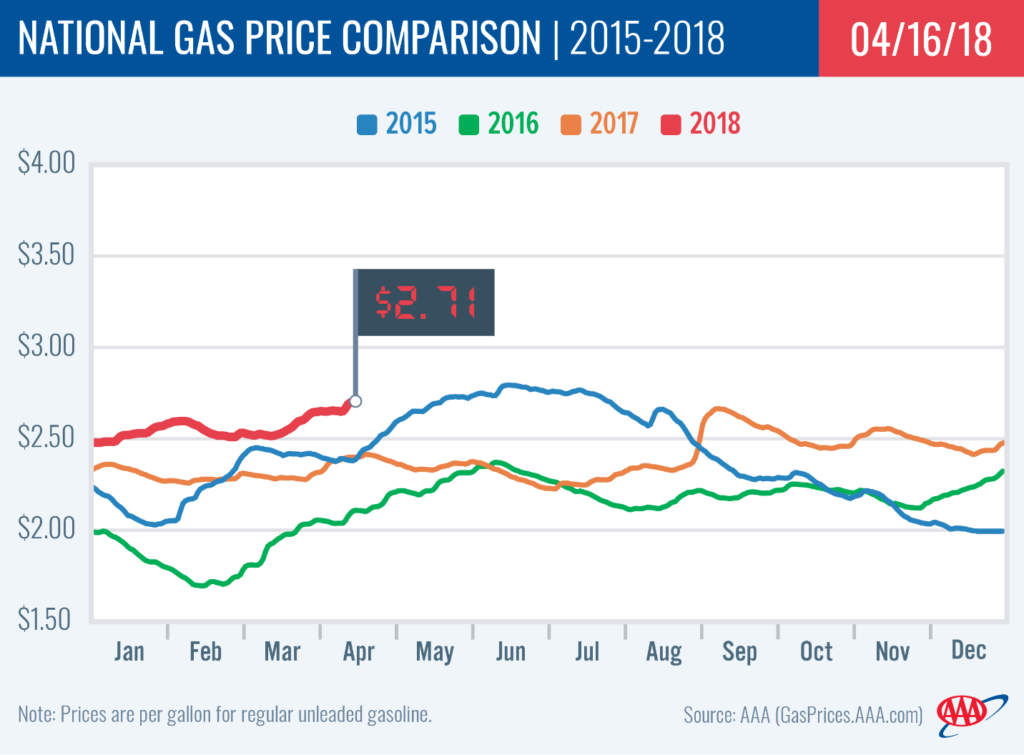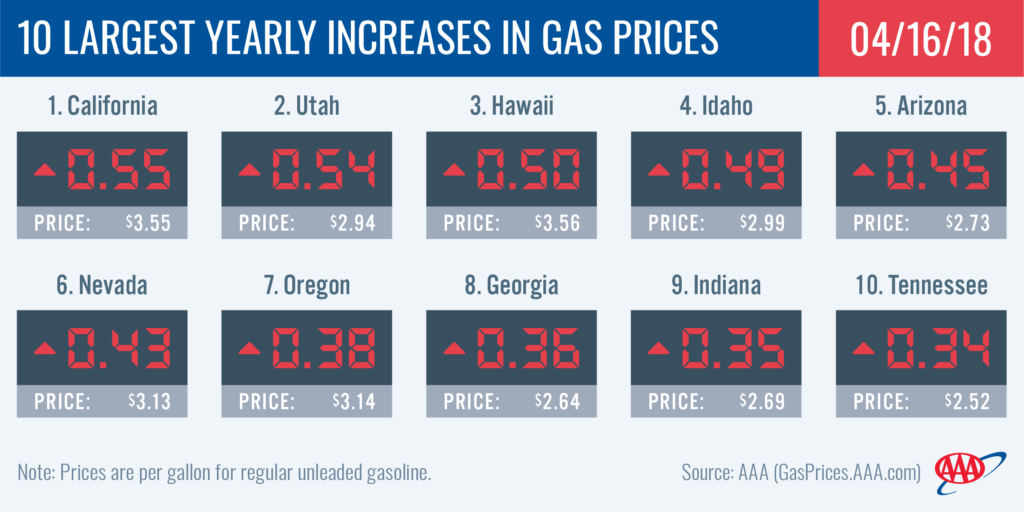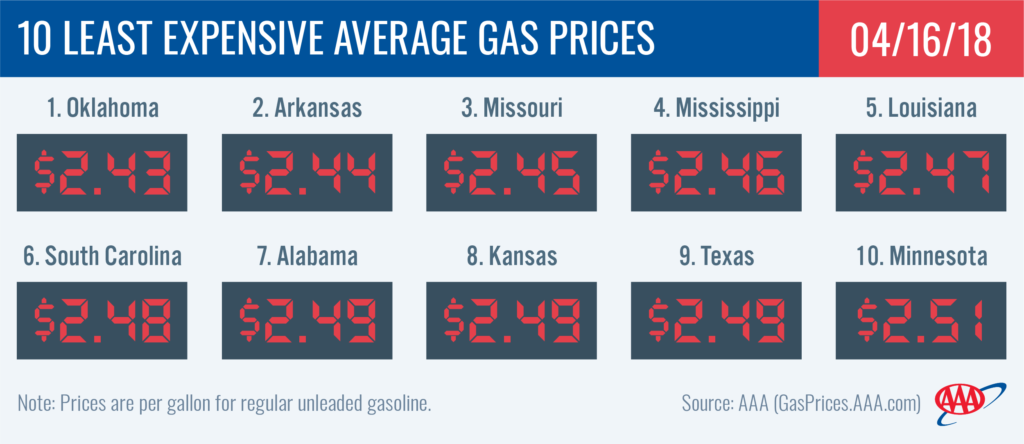At $2.71, gas prices are at their most expensive point in nearly three years and continue to climb. On the week, the national average increased a nickel. Motorists in six west coast states are paying more than $3/gallon. Across the country, only 27 percent of gas stations are selling gas for $2.50 or less.
“Expensive crude oil prices, unrest in the Middle East, strong domestic demand, record production rates and global oil supply surplus have created the perfect storm to drive spring gas prices toward new heights,” said Jeanette Casselano, AAA spokesperson. “Consumers can expect gas prices to increase another 5 to 10 cents this season, but the national average is not expected to reach the $3 mark.”
Today’s gas price average is 18-cents more than a month ago and 30-cents more than a year ago.
“AAA forecast that two-thirds of the 88 million families taking vacation this summer plan to drive to their destination. With more expensive gas prices on the horizon, travelers should plan now for the additional costs,” added Casselano.

Quick Stats
- The nation’s top 10 largest increases from one year ago are: California (+55 cents), Utah (+54 cents), Hawaii (+50 cents), Idaho (+49 cents), Arizona (+45 cents), Nevada (+43 cents), Oregon (+38 cents), Georgia (+36 cents), Indiana (+35 cents) and Tennessee (+34 cents).
- The nation’s top 10 least expensive markets are: Oklahoma ($2.43), Arkansas ($2.44), Missouri ($2.45). Mississippi ($2.46), Louisiana ($2.47), South Carolina ($2.48), Alabama ($2.49), Kansas ($2.49), Texas ($2.49) and Minnesota ($2.51).

West Coast
Drivers in the West Coast region are paying some of the highest gasoline prices in the nation: Hawaii ($3.56), California ($3.55), Washington ($3.23), Alaska ($3.20), Oregon ($3.14) and Nevada ($3.13). On the week, all average prices for unleaded regular gasoline in the West Coast states are up. Arizona (+7 cents) is not only seeing the largest increase in its average price in the region, but lands on the top 10 list of states paying the highest prices this week. Prices are significantly more expensive compared to a year ago with many states paying more than or nearly 50-cents more to fill up: California (+55 cents), Hawaii (+50 cents) and Arizona (+45 cents).
According to the Energy Information Administration’s (EIA) latest report for the week ending on April 6, gasoline inventories in the region fell by 600,000 bbl to 31.4 million bbl. This draw marks the third consecutive draw in the region. Although inventories continue to drop, they are now approximately 1.5 million bbl higher than they were at this time in 2017.
Great Lakes and Central
Gas prices are more expensive on the week across all states in the Great Lakes and Central region. With a 6 cent or more increase, three states land on this week’s top 10 list with the largest increases: Michigan (+10 cents), Illinois (+7 cents) and Missouri (+7 cents).
The average gas price in the region is $2.60 with Missouri ($2.45) selling the cheapest and Michigan ($2.78) selling the most expensive gasoline.
Gasoline inventories remained relatively stable on the week in the Great Lakes and Central region. In total, inventories dropped by 26,000 bbl. This marks the fifth week of inventory declines. However, at 58 million bbl in total, inventories are 2 million bbl stronger than early April 2017.
South and Southeast
Excluding New Mexico ($2.63), Georgia ($2.64) and Florida ($2.62), all states in the South and Southeast region are paying the cheapest gas prices in the country. At $2.43, Oklahoma has the lowest gas price average in the country, which is 29-cents more expensive than the lowest price average this time last year, which was held by South Carolina ($2.14).
With a 7-cent jump, Georgia and Texas tied for the region’s largest increase on the week.
The EIA reports a decline in stocks for a second week in the South and Southeast with inventories dropping 1.5 million bbl – the largest decrease of all regions. Overall, total inventories register at 82 million bbl.

Mid-Atlantic and Northeast
West Virginia (+8 cents) tops the region with the largest jump in gas prices for a consecutive week. North Carolina, Tennessee and Virginia saw the second largest changes (+6 cents) among the Mid-Atlantic and Northeast states. Delaware ($2.61) was the only state in the region and country to see the gas price average hold steady.
Pennsylvania ($2.92) is just 8-cents away from hitting the $3/mark. Prices in the state hit a high of $2.90 in both June 2015 and September 2017, but have not risen above that threshold since November 2014.
Gasoline inventories in the region jumped for a second week, adding a substantial 3 million bbl, according to the latest EIA data. This was the only build in inventories of any region in the country on the week. With the upward notch, total gasoline inventories register just above the 61 million bbl mark.
Rockies
Utah (+13 cents), Colorado (+10 cents) and Idaho (+10 cents) top this week’s top 10 list with the largest increases in the country. Both Idaho ($2.99) and Utah ($2.94) are pennies away from reaching the $3 mark, which either state has not seen since summer of 2015. Both states also land on the top 10 states list with the most expensive gas prices.
On the week, gas prices jumped 5 cents in Wyoming and 3 cents in Montana. Prices are expected to continue to climb as tourist season approaches in the Rockies. Motorists filling up in the region this summer can expect gas prices to be at least 40 cents or more expensive than last summer.
Gasoline inventory continued to drop this past week, falling by 500,000 bbl. Total inventories sit at 7.5 million bbl, the lowest for early April since 2015.
Oil market dynamics
At the close of Friday’s formal trading session on the NYMEX, WTI settled at $67.39. Last week, WTI traded at the highest levels since December 2014 and are expected to continue to build momentum this week. Oil prices edged higher last week following new concerns about tension in the Middle East. Following the weekend’s air strikes in Syria, it’s likely prices will go higher. Although Syria is not a major oil producer, tension in the country could ripple to other countries in the region and restrict global oil supply flows.
In its latest report, EIA data for the week ending on April 6 shows domestic crude production in the U.S. hit a new record high of 10.53 million b/d. The increased output led crude storage levels to grow by 3.3 million bbl to 428.6 million bbl. With Baker Hughes, Inc. reporting that the U.S. added seven oil rigs last week – bringing the total to 815 – crude production in the U.S. is likely to continue growing.
Motorists can find current gas prices along their route with the free AAA Mobile app for iPhone, iPad and Android. The app can also be used to map a route, find discounts, book a hotel and access AAA roadside assistance. Learn more at AAA.com/mobile.
